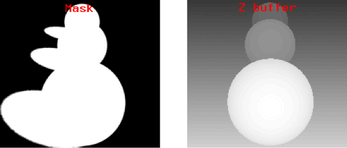During rendering, Maya software can generate an image file that contains color channels (RGB), a mask channel (RGBA), a depth channel (RGBZ) or a combination of the three (RGBAZ). For more information on color channels, see Color, Depth, and Mask (alpha) channels.

Some image formats cannot include embedded mask or depth channels; in these cases, Maya can generate a separate mask or depth file.
By default, Maya generates an image file with three color channels and a mask channel. Mask channels and depth channels are mainly used for compositing. You can control the types of channels Maya includes in rendered image files. For instance, if you don’t plan on compositing rendered images, you don’t have to generate mask or depth channels during rendering.
To turn channels on or off, see Enable color, depth, and mask channels for rendered images.
A mask channel (or alpha channel) defines where an image is opaque or transparent. Opaque regions of the objects are white, semi-transparent regions are gray, and transparent regions are black.
Use a mask channel to layer images for compositing software. For instance, you can use the mask channel of an image as a matte to composite an object (without its background) with another image.
A depth channel (or Z depth or Z buffer channel) provides 3D information about an image. It represents the distance of objects from the camera.
Depth channels are used by compositing software. For instance, you can use the depth channel to correctly composite several layers while respecting the proper occlusions.
Maya stores depth values as -1/z. These represent the near and far clipping values.
Arranging objects in order in 3D space
When you render in layers the compositing application must be able to tell which part of which object goes behind or in front of another one. Alpha channels do not contain this information, so you can use the Black Hole mode of the Matte Opacity feature in Maya to produce cutout regions that composite correctly. See Modify a mask channel.
To set up layers and passes, see Render layer overview and Appendix B: Render Passes for Maya software renderer.